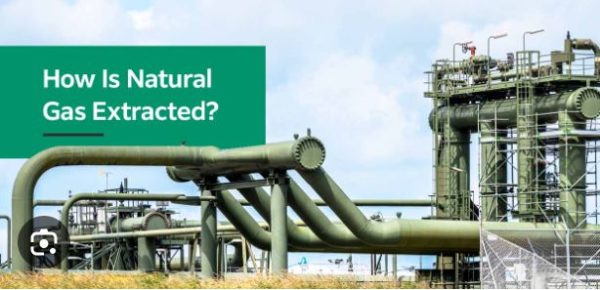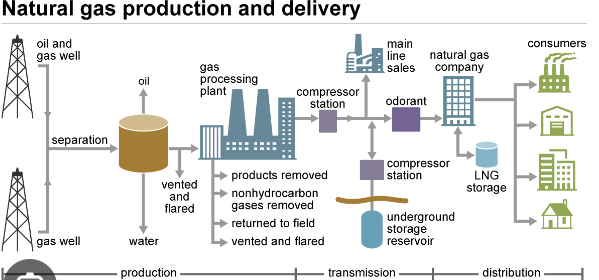In this post we will be looking at meaning of natural Gas, the natural and plants, Natural gas separation and refining.
Natural-gas processing starts underground or at the well-head. If the gas is being produced, for instance, alongside crude oil, the separation process already transpires as the fluid flows through the reservoir rocks until it reaches the well tubing. The process beginning at the wellhead extracts the composition of natural gas according to the type, depth, and location of the underground deposit and the geology of the area. Oil and natural gas are often found together in the same reservoir. The natural gas produced from oil wells is generally classified as associated-dissolved gas meaning that the gas had been associated with or dissolved in crude oil.
Read: OIL PRODUCTION NOW 1.7 MILLION BARRELS DAILY, SAYS FG
Natural gas production not associated with crude oil is classified as “non-associated.” In 2009, 89 percent of U.S. wellhead production of natural gas was non-associated. Non-associated gas that produces a dry gas in terms of condensate and water are sent directly to a pipeline or gas plant with undergoing any separation process. Natural-gas processing plants purify raw natural gas by removing contaminants such as solids, water, carbon dioxide (CO2), hydrogen sulfide (H2S), mercury and higher molecular mass hydrocarbons. Some of the substances which contaminate natural gas have economic value and are further processed or sold. An operational natural gas plant delivers pipeline-quality dry natural gas that can be used as fuel by residential, commercial and industrial consumers, or as a feedstock for chemical synthesis.
WHAT IS NATURAL GAS?
Natural gas (or fossil gas) is hiding beneath the surface and extracted both from under the ocean and land. Natural gas consists mainly of methane but includes a varying number of alkanes, nitrogen, helium, carbon dioxide, water vapor, propane, butane, and hydrogen sulphide. Natural gas formed hundreds of millions of years ago. The heat and gravity decomposed the dead plants and animals and turned them into petroleum, oil, or natural gas. Most of the time natural gas can be found near oil reservoirs, and because of that, a separation is needed after extraction. Natural gas is essential for modern life. Raw natural gas is composed of a series of hydrocarbons and other elements. Companies use processing facilities to make it suitable for gas transmission and the end-user.

The Natural Gas Extraction Process
There are four types of natural gas extractions:
- Vertical drilling
- Horizontal drilling
- Hydraulic Fracturing / Fracking
- Acidizing
The extraction process depends on how deep the natural gas is below the surface and if there is anything unconventional (rocks that need to be broken up) that could make the extraction less efficient. Natural gas processing starts with the extraction and begins in the wells. Natural gas can come up through crude oil wells, gas wells, and condensate wells. Natural gas is sometimes just an associated gas that was found and extracted with oil.
Natural Gas Processing Plants
The following are various ways natural gas is processed:
- planning & extraction
- separation (from oil)
- removals: water, sulphur, and carbon dioxide removal
- separation of natural gas liquids
- odorant phase: natural gas is odourless, thus it is dangerous. Giving natural gas an odour has safety reasons.
- compression station
- storage
- transportation
Natural Gas Separation and Refining
Separation starts with oil. The most common method is to use equipment called Conventional Separator which is placed near wellheads so it can start separating right after natural gas came to the surface. It works with gravity: in a simple, closed tank the heavier oil separates from the lighter gas. Separation starts with oil. The most common method is to use equipment called Conventional Separator which is placed near wellheads so it can start separating right after natural gas came to the surface. It works with gravity: in a simple, closed tank the heavier oil separates from the lighter gas. Groundwater comes with natural gas many times. Removing the associated water happens right after oil separation and is a more complex procedure. The process involves absorption, or adsorption, depending on the water’s condensation.
Read: Uses and Benefits of Compressed Natural Gas
Natural gas liquids: the cryogenic expansion process
Natural gas liquids are not the same as LNG (liquefied natural gas). Additional liquids like oil, butanes, and pentanes have to be removed from the natural gas. The cryogenic expansion process removes lighter hydrocarbons too (such as ethane). The process starts with a dramatic dropping in the temperature: the gas stream reduces to around -85 degrees C. The cryogenic expansion process produces a cleaner natural gas. When natural gas takes its final form, odorant phase, storage and transportation are left on the to-do list. ‘Giving’ an odor to natural gas is a key factor: the smell is like an alarm, so it is easier to recognize leaking in the systems when transported. All that is left is to transport the natural gas into the desired destination. Natural gas can be stored both as a gas or liquified. Gaseous fossil fuel is transported by gas stream pipelines for long distances, while LNG can be shipped to territories where pipelines cannot be built (islands for example).
CONCLUSION.
- Natural gas breaks to the surface with additional gases and liquids.
- Processing plants have to separate natural gas from oil.
- Removing the additional gases makes natural gas purer.
- The cryogenic expansion process refines natural gas to its final form.

